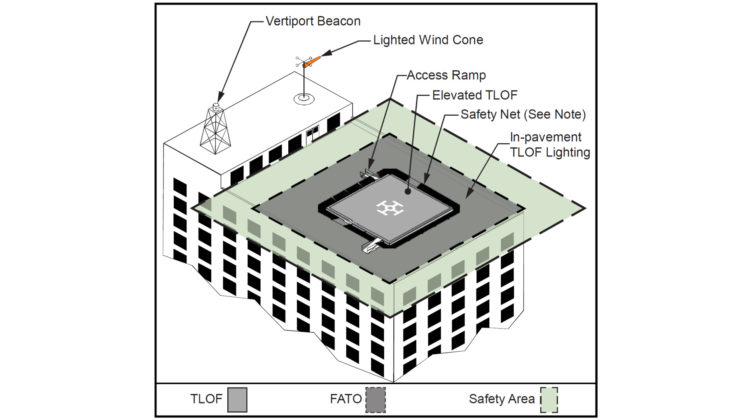
The US Federal Aviation Administration (FAA) has released a set of new design guidelines for vertiports – the infrastructure that will support the vertical take-off and landing (VTOL) aircraft currently being developed as ‘flying taxis’ for what’s known as urban air mobility (UAM).
According to the FAA, the design standards will serve as the initial step to provide key information for airport owners, operators and infrastructure developers to begin development of facilities that will support operations of UAM aircraft that are electrically powered and take-off and land vertically. These VTOL operations will transport passengers or cargo at lower altitudes in rural, urban and suburban areas.
The final design standards are based on research conducted by the FAA, collaboration with industry partners and feedback from the public.
‘Our country is stepping into a new era of aviation,’ said Shannetta Griffin, associate administrator for airports. ‘These vertiport design standards provide the foundation needed to begin safely building infrastructure in this new era.’
The design standards include critical information that designers and builders will need to follow to allow for safe take-offs and landings. Some of these include:
Safety-critical geometry and design elements: Dimensions for vertiport touchdown and lift-off areas, additional airspace needed for approach and departure paths, and load-bearing capacity. In the future, the FAA anticipates a high rate of operations at many vertiports.
Lighting, markings and visual aids: Guidelines on markings, lighting and visual aids that identify the facility as a vertiport. The FAA recommends the use of the Vertiport Identification Symbol, as shown in the middle of the graphic above.
Charging and electric infrastructure: Initial safety standards and guidelines for the batteries and charging equipment that will be central to vertiports.
On-airport vertiports: Requirements for airports looking to add vertiports to an existing commercial airport, including the distance a vertiport would have to be from a current runway.
Elevated vertiports: Requirements and guidelines for vertiports that may be on top of existing structures.
This vertiport guidance will be used until performance-based vertiport design guidance is developed.
‘At this time, the FAA does not have enough validated VTOL aircraft performance data and necessarily is taking a prescriptive and conservative approach with the recommendations in this EB,’ the engineering brief notes. ‘Vertiport guidance is expected to evolve into a performance-based design standard, potentially with aircraft grouped by their performance characteristics.’
The guidelines are available for download here.



